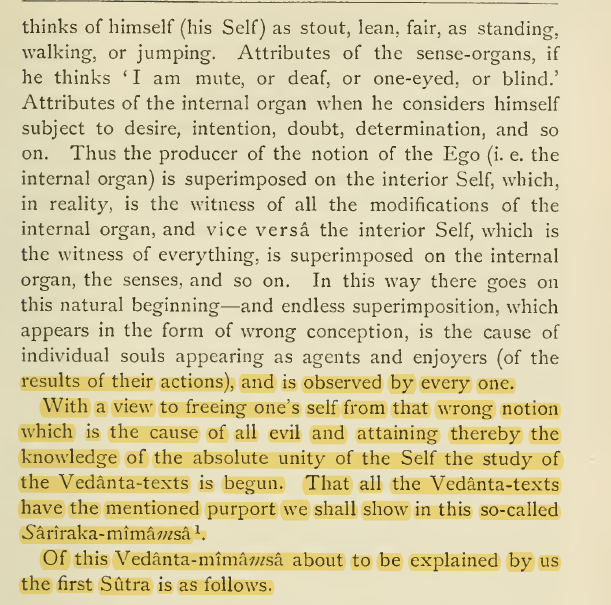A nano-Adhyasa Bhashya in the Brihadaranyaka Bhashya
58 views
Skip to first unread message
V Subrahmanian
May 6, 2022, 6:15:50 AM5/6/22
to Advaitin
The Brihadaranyaka 1.4.10 passage, a lengthy one, is seminal to Advaita as it contains the famous Mahavakya 'Aham Brahma asmi'. It also has many other doctrinal points unique to Advaita. In the Bhashyam, which is also very lengthy, here is a paragraph that at once reminds one of the Adhyasa bhashya which is the preamble to the Brahma Sutra Bhashya:



तद्यथेहैव तावत् — अथ यः कश्चिदब्रह्मवित् , अन्यामात्मनो व्यतिरिक्तां यां काञ्चिद्देवताम् , उपास्ते स्तुतिनमस्कारयागबल्युपहारप्रणिधानध्यानादिना उप आस्ते तस्या गुणभावमुपगम्य आस्ते — अन्योऽसावनात्मा मत्तः पृथक् , अन्योऽहमस्म्यधिकृतः, मया अस्मै ऋणिवत्प्रतिकर्तव्यम् — इत्येवंप्रत्ययः सन्नुपास्ते, न स इत्थंप्रत्ययः वेद विजानाति तत्त्वम् । न स केवलमेवंभूतः अविद्वान् अविद्यादोषवानेव, किं तर्हि, यथा पशुः गवादिः वाहनदोहनाद्युपकारैरुपभुज्यते, एवं सः इज्याद्यनेकोपकारैरुपभोक्तव्यत्वात् एकैकेन देवादीनाम् ; अतः पशुरिव सर्वार्थेषु कर्मस्वधिकृत इत्यर्थः । एतस्य हि अविदुषो वर्णाश्रमादिप्रविभागवतोऽधिकृतस्य कर्मणो विद्यासहितस्य केवलस्य च शास्त्रोक्तस्य कार्यं मनुष्यत्वादिको ब्रह्मान्त उत्कर्षः ; शास्त्रोक्तविपरीतस्य च स्वाभाविकस्य कार्यं मनुष्यत्वादिक एव स्थावरान्तोऽपकर्षः ; यथा चैतत् तथा ‘अथ त्रयो वाव लोकाः’ (बृ. उ. १ । ५ । १६) इत्यादिना वक्ष्यामः कृत्स्नेनैवाध्यायशेषेण । विद्यायाश्च कार्यं सर्वात्मभावापत्तिरित्येतत् सङ्क्षेपतो दर्शितम् । सर्वा हि इयमुपनिषत् विद्याविद्याविभागप्रदर्शनेनैवोपक्षीणा । यथा च एषोऽर्थः कृत्स्नस्य शास्त्रस्य तथा प्रदर्शयिष्यामः ॥

The highlighted lines are the ones that are so similar to the Adhyasa bhashya theme and the ending:
अध्यासो नाम अतस्मिंस्तद्बुद्धिरित्यवोचाम । तद्यथा — पुत्रभार्यादिषु विकलेषु सकलेषु वा अहमेव विकलः सकलो वेति बाह्यधर्मानात्मन्यध्यस्यति ; तथा देहधर्मान् ‘स्थूलोऽहं कृशोऽहं गौरोऽहं तिष्ठामि गच्छामि लङ्घयामि च’ इति ; तथेन्द्रियधर्मान् — ‘मूकः काणः क्लीबो बधिरोऽन्धोऽहम्’ इति ; तथान्तःकरणधर्मान् कामसङ्कल्पविचिकित्साध्यवसायादीन् । एवमहंप्रत्ययिनमशेषस्वप्रचारसाक्षिणि प्रत्यगात्मन्यध्यस्य तं च प्रत्यगात्मानं सर्वसाक्षिणं तद्विपर्ययेणान्तःकरणादिष्वध्यस्यति । एवमयमनादिरनन्तो नैसर्गिकोऽध्यासो मिथ्याप्रत्ययरूपः कर्तृत्वभोक्तृत्वप्रवर्तकः सर्वलोकप्रत्यक्षः । अस्यानर्थहेतोः प्रहाणाय आत्मैकत्वविद्याप्रतिपत्तये सर्वे वेदान्ता आरभ्यन्ते । यथा चायमर्थः सर्वेषां वेदान्तानाम् , तथा वयमस्यां शारीरकमीमांसायां प्रदर्शयिष्यामः । वेदान्तमीमांसाशास्त्रस्य व्याचिख्यासितस्येदमादिमं सूत्रम् —


Both in the Brihadaranyaka bhashya cited above and in the Adhyasa bhashya cited above, at the end, Shankara makes a claim: That such is the purport of the entire Upanishadic lore, we shall demonstrate in the sequel. This declaration is very significant in appreciating the view of Shankara that it is adhyasa, error, that is at the root of bondage and the remedy lies in the teaching of the Scripture. It is also to be noted that in the case of the Upanishad bhashya the declaration is made at the 1.4.10, fairly the beginning of the Upanishad. And in the Adhyasa bhashya too, it is obvious that the declaration is made at the very beginning of the Sutra bhashya. Even the wordings in the original, at both the places, are so similar.
This statement, at the end of the Upanishad bhashya above सर्वा हि इयमुपनिषत् विद्याविद्याविभागप्रदर्शनेनैवोपक्षीणा । reminds one of the Bhagavadgita 13th chapter which is termed 'kshetra - kshetrajna vibhaga yogaH', the chapter on the discrimination of the matter and spirit, anatma and the atman. In the commentary for this chapter too, we have a fine glimpse of the Adhyasa bhashya.
A humble homage to the Great Acharya on this day, the Shankara Jayanti.
Om Tat Sat
Reply all
Reply to author
Forward
0 new messages
